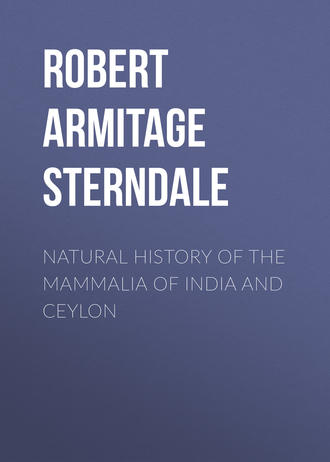 полная версия
полная версияNatural History of the Mammalia of India and Ceylon
Bats are mostly insectivorous; a few are fruit-eaters, such as our common flying-fox. They produce from one to two at a birth, which are carried about by the mother and suckled at the breast, this peculiarity being one of the anatomical details alluded to as claiming for the bats so high a place.
Bats are divided into four sub-families—Pteropodidæ, Vampyridæ, Noctilionidæ, and Vespertilionidæ.
MEGACHIROPTERASUB-FAMILY PTEROPODIDÆGENUS PTEROPUSThese are frugivorous bats of large size, differing, as remarked by Jerdon, so much in their dentition from the insectivorous species that they seem to lead through the flying Lemurs (Colugos) directly to the Quadrumana. The dentition is more adapted to their diet; they have cutting incisors to each jaw, and grinders with flat crowns, and their intestines are longer than those of the insectivorous bats. They produce but one at birth, and the young ones leave their parents as soon as they can provide for themselves. The tongue is covered with rough papillæ. They have no tail. These bats and some of the following genus, which are also frugivorous, are distinguished from the rest of the bats by a claw on the first or index finger, which is short.
Dental formula: Inc., 4/4; can., 1—1/1—1; premolars, 2—2/3—3; molars, 3—3/3—3.
NO. 31. PTEROPUS EDWARDSII vel MEDIUSThe Common Flying Fox (Jerdon's No. 12)NATIVE NAMES.—Badul, Bengali and Mahratti; Wurbagul, Hindi; Toggul bawali, Canarese; Sikurayi, Telegu.
HABITAT.—All through India, Ceylon, and Burmah.
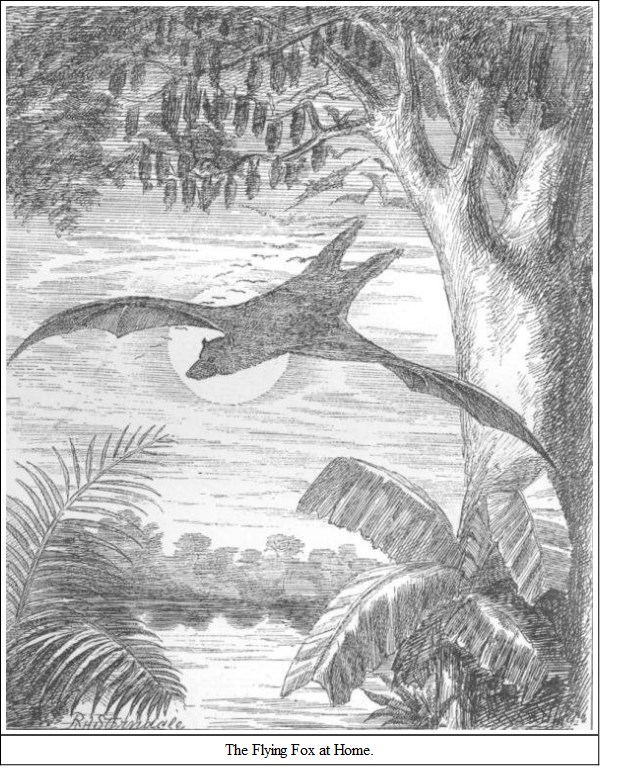
DESCRIPTION.—Head and nape rufous black; neck and shoulders golden yellow (the hair longer); back dark brown; chin dark; rest of body beneath fulvous or rusty brown; interfemoral membrane brownish black.—Jerdon.
SIZE.—Length, 12 to 14 inches; extent of wings, 46 to 52 inches.
These bats roost on trees in vast numbers. I have generally found them to prefer tamarinds of large size. Some idea of the extent of these colonies may be gathered from observations by McMaster, who attempted to calculate the number in a colony. He says: "In five minutes a friend and I counted upwards of six hundred as they passed over head, en route to their feeding grounds; supposing their nightly exodus to continue for twenty minutes, this would give upwards of two thousand in one roosting place, exclusive of those who took a different direction."
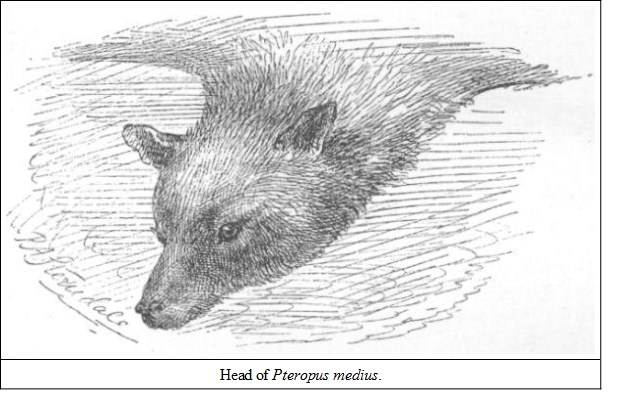
Tickell's account of these colonies is most graphic, though Emerson Tennent has also given a most interesting and correct account of their habits. The former writes:—"From the arrival of the first comer until the sun is high above the horizon, a scene of incessant wrangling and contention is enacted among them, as each endeavours to secure a higher and better place, or to eject a neighbour from too close vicinage. In these struggles the bats hook themselves along the branches, scrambling about hand over hand with some speed, biting each other severely, striking out with the long claw of the thumb, shrieking and cackling without intermission. Each new arrival is compelled to fly several times round the tree, being threatened from all points, and, when he eventually hooks on, he has to go through a series of combats, and be probably ejected two or three times before he makes good his tenure." For faithful portraying, no one could improve on this description. These bats are exceeding strong on the wing. I was aware that they went long distances in search of food, but I was not aware of the power they had for sustained flight till the year 1869, when, on my way to England on furlough, I discovered a large flying fox winging his way towards our vessel, which was at that time more than two hundred miles from land. Exhausted, it clung on to the fore-yard arm; and a present of a rupee induced a Lascar to go aloft and seize it, which he did after several attempts. The voracity with which it attacked some plantains showed that it had been for some time deprived of food, probably having been blown off shore by high winds. Hanging head-downwards from its cage, it stuffed the fruit into its cheeks, monkey-fashion, and then seemed to chew it at leisure. When I left the steamer at Suez it remained in the captain's possession, and seemed to be tame and reconciled to its imprisonment, tempered by a surfeit of plantains. In flying over water they frequently dip down to touch the surface. Jerdon was in doubt whether they did this to drink or not, but McMaster feels sure that they do this in order to drink, and that the habit is not peculiar to the Pteropodidæ, as he has noticed other bats doing the same. Colonel Sykes states that he "can personally testify that their flesh is delicate and without disagreeable flavour;" and another colonel of my acquaintance once regaled his friends on some flying fox cutlets, which were pronounced "not bad." Dr. Day accuses these bats of intemperate habits; drinking the toddy from the earthen pots on the cocoanut trees, and flying home intoxicated. The wild almond is a favourite fruit.
Mr. Rainey, who has been a careful observer of animals for years, states that in Bengal these bats prefer clumps of bamboos for a resting place, and feed much on the fruit of the betel-nut palm when ripe. Another naturalist, Mr. G. Vidal, writes that in Southern India the P. medius feeds chiefly on the green drupe or nut of the Alexandrian laurel (Calophyllum inophyllum), the kernels of which contain a strong-smelling green oil on which the bats fatten amazingly; and then they in turn yield, when boiled down, an oil which is recommended as an excellent stimulative application for the hair. I noticed in Seonee a curious superstition to the effect that a bone of this bat tied on to the ankle by a cord of black cowhair is a sovereign remedy, according to the natives, for rheumatism in the leg. Tickell states that these bats produce one at a time in March or April, and they continue a fixture on the mother till the end of May or beginning of June.
NO. 32. PTEROPUS LESCHENAULTII (CYNONYCTERIS AMPLEXICAUDATA)The Fulvous Fox-Bat (Jerdon's No. 13)Dobson places this bat in the sub-group Cynonycteris. It seems to differ from Pteropus only, as far as I can see, in having a small distinct tail, though the above-quoted author considers it closely allied to the next genus.
HABITAT.—The Carnatic, Madras and Trichinopoly; stated also procurable at Calcutta and Pondicherry (Jerdon); Ceylon (Kellaart).
DESCRIPTION.—Fur short and downy; fulvous ashy, or dull light ashy brown colour, denser and paler beneath; the hairs whitish at the base; membranes dark brown.
SIZE.—Length, 5 to 5½ inches; extent of wing, 18 to 20 inches.
More information is required regarding the habits of this bat.
GENUS CYNOPTERUSThis genus has four molars less than the last, a shorter muzzle; the cheek-bones or zygomatic arch more projecting; tongue rather longer and more tapering, and slightly extensile.
Dental formula: Inc., 4/4 or 4/2; can., 1—1/1—1; premolars, 2—2/3—3; molars, 2—2/2—2.
NO. 33. CYNOPTERUS MARGINATUSThe Small Fox-Bat (Jerdon's No. 14)NATIVE NAME.—Chamgadili, Hindi; Coteekan voulha, Singhalese.
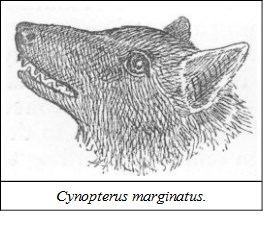
HABITAT.—India generally, and Ceylon.
DESCRIPTION.—General colour fulvous olivaceous, paler beneath and with an ashy tinge; ears with a narrow margin of white (Jerdon.) A reddish smear on neck and shoulders of most specimens; membranes dusky brown. Females paler (Kellaart).
SIZE.—Length, 4½ to 5½ inches; extent of wing, 17 to 20 inches.
This bat is found all over India; it is frugivorous exclusively, though some of this sub-order are insectivorous. Blyth says he kept some for several weeks; they would take no notice of the buzz of an insect held to them, but are ravenous eaters of fruit, each devouring its own weight at a meal, voiding its food but little changed whilst slowly munching away; of guava it swallows the juice only. Blyth's prisoners were females, and after a time they attracted a male which hovered about them for some days, roosting near them in a dark staircase; he was also caught, with one of the females who had escaped and joined him. Dr. Dobson writes that in three hours one of these bats devoured twice its own weight. This species usually roosts in trees.
NO. 34. MACROGLOSSUS (PTEROPUS) MINIMUSThe Tenasserim Fox-BatNATIVE NAME.—Lowo-assu (dog-bat), Javanese.
HABITAT.—The Himalayas, Burmah, Tenasserim, and the Indian Archipelago.
DESCRIPTION.—Ears half length of head, narrow and rounded at tip; face abruptly narrowed in front of eyes; muzzle long, narrow, cylindrical; lower jaw slightly projecting; eyes large; tongue very long, last third attenuated, covered with brush-like papillæ; interfemoral membrane very narrow, especially at root of tail; fur reddish brown, and very long.
SIZE.—Head and body, 2-3/10 inches.
Like other Pteropi this bat feeds on fruit of every description, but particularly attacks the various cultivated varieties of Eugenia (Jamoon).
GENUS EONYCTERISMuzzle long and cylindrical; nostrils scarcely projecting; upper lip with a shallow vertical groove in front; index finger without a claw; thumb short; part of the terminal phalanx included in the wing membrane; metacarpal bone of the second finger equal to the index finger in length; tail short and distinct; the base contained in the narrow interfemoral membrane; tongue long, as in Macroglossus.
Dentition: Inc., 4/4; can., 1—1/1—1; premolars, 2—2/2—2; molars, 3—3/3—3.
NO. 35. EONYCTERIS SPELÆAHABITAT.—Burmah.
DESCRIPTION.—Head long; muzzle narrow, cylindrical, abruptly narrowed in front of the eyes; nostrils with an intervening emargination, which also passes down to the lips; tongue very long and pointed; ears conical, with rounded tips; body clothed with very short and thinly-spread fur of a uniform dark brown colour; the fur on the head extends only as far as the inner corners of the eye, leaving the rest of the face naked; tail half an inch. On each side, and a little behind the anal opening, are two small, kidney-shaped subcutaneous glandular bodies.
SIZE.—Head and body, 4 inches; tail, ½ inch.
Found in Farm Caves, Moulmein. The absence of the claw on the index finger is specially to be noted.
MICROCHIROPTERASUB-FAMILY VAMPYRIDÆGENUS MEGADERMABats with simple or complicated nose-leaves or membranes. The conch of the ear very large, and joined together on the top of the head; tragus large and bifurcated; nasal membranes complicated; no tail; wings remarkably ample. They have four incisors below but none above, the intermaxillaries remaining cartilaginous.
Dental formula: Inc., 0/4; can., 1—1/1—1; pre-m., 2—2/2—2; molars, 3—3/3—3.
NO. 36. MEGADERMA LYRAThe Large-eared Vampire Bat (Jerdon's No. 15)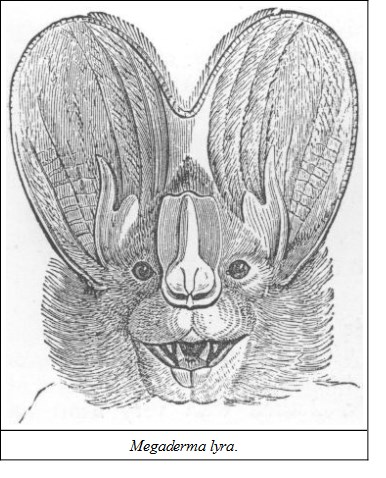
HABITAT.—India and Ceylon.
DESCRIPTION.—Above ashy blue, slaty or pale mouse colour; albescent or yellowish ashy beneath; nasal appendage large, oblong, free at the tip, reaching to the base of the ears with a fold down the centre; tragus (oreillon) cordate, two-lobed, anterior long, narrow and pointed, posterior lobe half the height and rounded; muzzle truncated; under-lip cleft; wing membranes dark brown.
SIZE.—Head and body, 3 or 3½ inches; wing extent, 14 to 19 inches.
Very abundant in old buildings. They are beyond doubt blood-suckers. Blyth noticed one fly into his room one evening with a small vespertilio, which it dropped on being chased. The smaller bat was weak from loss of blood, and next morning (the Megaderm having been caught), on both bats being put into the same cage, the little one was again attacked and devoured; it was seized both times behind the ear. McMaster writes that in Rangoon he had a tame canary killed by a bat, and the bird's mate soon afterwards was destroyed in the same way. The case was clearly proved.
Mr. Frith informed Mr. Blyth that these bats were in the habit of resorting to the verandah of his house at Mymensing, and that every morning the ground under them was strewed with the hind quarters of frogs, and the wings of large grasshoppers and crickets. On one occasion the remains of a small fish were observed; but frogs appeared to be their chief diet—never toads; and of a quiet evening these animals could be distinctly heard crunching the heads and smaller bones of their victims.
NO. 37. MEGADERMA SPECTRUMThe Cashmere Vampire (Jerdon's No. 16)HABITAT.—Cashmere.
DESCRIPTION.—Above slaty cinereous, whitish beneath; the vertical nose-leaf of moderate size, oval; inner lobe of tragus ovate (Jerdon).
SIZE.—Two and three-quarter inches.
Dobson makes this bat synonymous with the last.
NO. 38. MEGADERMA SPASMAHABITAT.—Tenasserim, Ceylon.
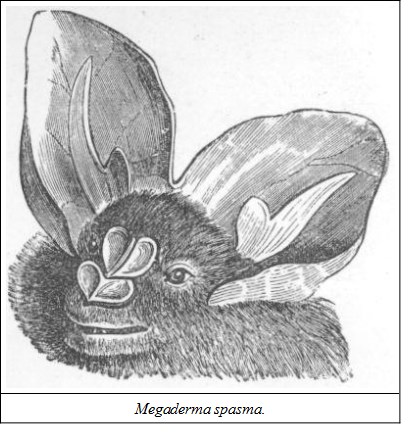
DESCRIPTION.—Muzzle, ear-conch, and tragus similar to those of M. lyra; the posterior portion of the tragus, however, is longer and more attenuated upwards, and more acutely pointed; the nose-leaf is shorter, with convex sides; but the anterior concave disc is considerably larger, and the base of the thickened process is cordate; thumbs and wings as in M. lyra; interfemoral membrane deeper; the calcaneum stronger; colour the same.
SIZE.—Head and body, about 3 inches. This bat is alluded to by Jerdon as M. Horsfieldii.
RHINOLOPHINÆNasal leaf complicated, and crests resting on the forehead, presenting more or less the figure of a horse-shoe; tail long and placed in the interfemoral membrane; ears large, but separate, and not joined at the base, as in the last genus; without a tragus, but often with a lobe at the base of the outer margin; wings large and long; forefinger of a single joint.
GENUS RHINOLOPHUSNose-leaf cordate, or semi-orbicular, bi-lobed in front of the nostrils; a longitudinal crest along the nose and an erect frontal leaf posteriorly more or less lanceolate.—Jerdon.
Dental formula: Inc., 2/4; can., 1—1/1—1; premolars, 2—2/2—2; molars, 3—3/3—3.
NO. 39. RHINOLOPHUS PERNIGER vel LUCTUSThe Large Leaf-Bat (Jerdon's No. 17)HABITAT.—Nepaul, Darjeeling, Khasya Hills.
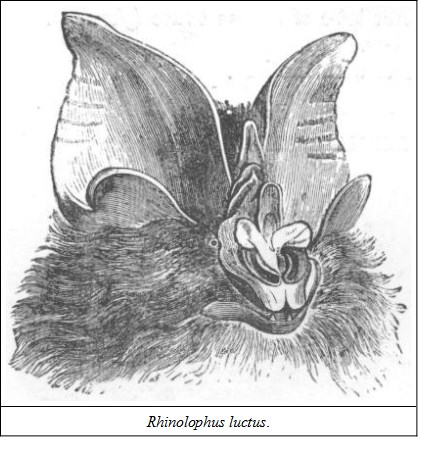
DESCRIPTION.—Ears very large, much longer than the head; broad, acutely pointed; nasal apparatus very complicated; the lower leaf very large, concealing the upper lip like a door knocker; the upper leaf like a graduated spire; ears transversely striate; a rather large semi-circular lobe at base of ear; fur long, dense, soft, and lax, slightly curled or woolly black with a silvery grizzle, or greyish-black or rich chestnut-brown.—Jerdon.
SIZE.—Length, 3¾; tail, 1¾; wing expanse, 17 inches.
NO. 40. RHINOLOPHUS MITRATUSThe Mitred Leaf-Bat (Jerdon's No. 18)HABITAT.—Chybassa, Central India, Mussoorie(?)
DESCRIPTION.—Ears large; anti-helix moderately developed; upper leaf triangular acute; tail extending beyond the tibia; color above light brown; paler beneath.—Jerdon.
SIZE.—Head and body, 2½ inches; tail, 1½ inch; wing expanse, 12 to 14 inches.
NO. 41. RHINOLOPHUS TRAGATUS vel FERRUM-EQUINUMThe Dark-brown Leaf-Bat (Jerdon's No. 19)HABITAT.—Nepaul, Mussoorie.
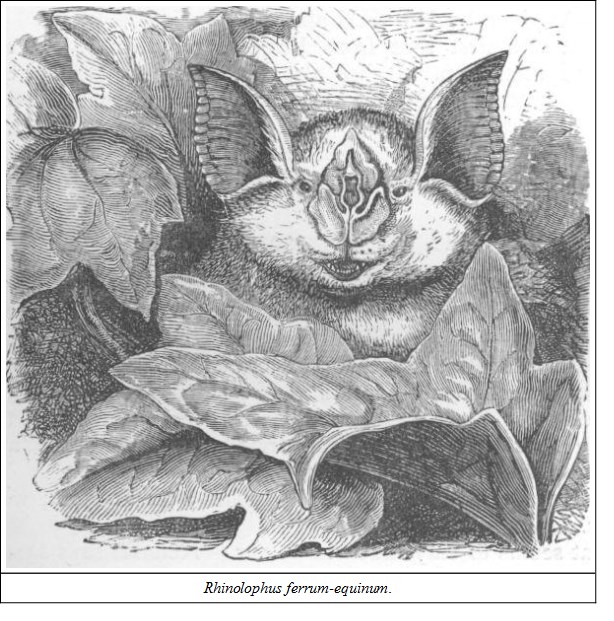
DESCRIPTION.—Upper process like a barbed spear-head; central one small and narrow, a little expanded at the summit; anti-tragus less developed than usual; lips simple; colour a uniform deep brown, with tips of the hair paler, and somewhat rusty.—Jerdon.
SIZE.—Head and body, 2-5/8 inches; tail, 1-7/8 inch; wing, 15½ inches.
The tail of this species seems unusually long. It is found in cavities of rock, and issues forth soon after dusk—sooner, according to Hodgson, than the species of vespertilio.
NO. 42. RHINOLOPHUS PEARSONIIPearson's Leaf-Bat (Jerdon's No. 20)HABITAT.—Lower Himalayan range, Darjeeling, Mussoorie, &c.
DESCRIPTION.—Colour above dark brown, with a slight shade of chestnut; underneath brown, with a sooty cast; fur very long, dense and soft; ears distinct, with an additional rounded lobe below, measuring anteriorly nearly three-fourths of an inch; point of the facial crest moderately developed; length from the tip of the nose to root of tail three inches; tail half an inch; length of fore-arm two inches; expanse of the wings eleven inches. Although allied to Mr. Hodgson's R. tragatus, possesses distinct characters.—Horsfield.
SIZE.—As given by Horsfield above.
This bat was first sent from Darjeeling by Mr. J. T. Pearson, and was named after him. It has also, according to Jerdon, been found by Captain Hutton at Mussoorie; it is therefore reasonable to suppose that it inhabits the whole range of the lower Himalayas. One striking difference between it and the last species is the very short tail, and it is easily to be recognised by the great length of the fur.
NO. 43. RHINOLOPHUS AFFINISThe Allied Leaf-Bat (Jerdon's No. 21)HABITAT.—Ceylon, Burmah, and perhaps the Malabar coast.
DESCRIPTION.—Above bright red ferruginous brown; tips of hair darker, paler beneath; ears pointed and external; edge deeply emarginated; internal edge and basal third of external surface hairy; anti-helix well developed; nasal process apparently very similar to that of R. mitratus (Kellaart). Upper leaf triangular, emarginate at the tip, reaching above the base of the ears (Jerdon).
SIZE.—Head and body about 2-3/10 inches; tail, 1 inch; wing extent, 12 inches.
This bat seems to vary much in colour. Kellaart says some are of a brighter red than others, and a few had a yellower tinge. Another marked variety was of a uniform pale yellow brown.
NO. 44. RHINOLOPHUS ROUXIThe Rufous Leaf-Bat (Jerdon's No. 22)HABITAT.—India generally.
DESCRIPTION.—Ears large, pointed, externally notched; tragus broad; tips of upper nose-leaf triangular, with its sides well emarginate, reaching above the base of the ears; no upper incisors [as in Megaderma lyra]; lower molars only five; canines very large; fur short, crisp; colour above smoky brown in some, reddish brown in others, and golden rufous in some; beneath paler.—Jerdon.
SIZE.—Length, 2-3/8 inches; tail, 1-1/8; wing expanse, 13 inches.
Hodgson considers this bat as allied to the two following species. It is the R. lepidus of Blyth.
NO. 45. RHINOLOPHUS MACROTISThe Large-eared Leaf-Bat (Jerdon's No. 23)HABITAT.—Lower Himalayas.
DESCRIPTION.—Ears very large, broad, oval, with pointed recurved tip, and a large obtuse tragus; anterior central crest of nose-leaf produced in front over the top of the flat transverse front edge; hinder leaf lanceolate triangular; above sooty brown or light earthy olive-brown, paler below, some with a rufous or Isabelline tint; no pubic teats.—Jerdon.
SIZE.—Head and body, 1¾ inch; tail, ¾; wing expanse, 9¾.
NO. 46. RHINOLOPHUS SUB-BADIUSThe Bay Leaf-Bat (Jerdon's No. 24)HABITAT.—Nepaul.
DESCRIPTION.—Ears not larger than the head, obtusely pointed and ovoid; nasal appendage quadrate, with a transverse bar nearly surmounting it; upper leaf triangular, with slightly emarginate sides; clear brown above, paler below and on head and face.
SIZE.—Head and body, 1½ inch; tail, 1¼; wing expanse, 7½.—Jerdon.
NO. 47. RHINOLOPHUS RAMMANIKA (Kellaart)HABITAT.—Ceylon.
DESCRIPTION.—Above rufescent, beneath ashy brown; face slightly fulvous; round the base of the ears and on the sides of the posterior half of the body bright fulvous; tail enclosed in the interfemoral membrane.
SIZE.—Head and body, 2½ inches; tail, 1; wing expanse, 10 inches.
This is a doubtful species. Dr. Kellaart got one from Amanapoora hill at Kaduganava. He says: "As the specimen reached us in a dried condition, we are unable to say anything more about its nasal processes than that in place of a transverse process above the nostrils it had a small triangular peak over the usual horse-shoe process surrounding the nasal opening. This triangular crest was hairy; superiorly there was no appearance of a sac above it to the best of our recollection."
NO. 48. RHINOLOPHUS ANDAMANENSISHABITAT.—Southern Andaman Island.
DESCRIPTION (apud Dobson).—Like R. affinis generally, but the anterior horizontal horse-shoe shaped membrane is very broad, completely concealing the muzzle when viewed from above, as in R. Pearsonii; the posterior terminal leaf is also much longer, produced backwards between the ears, and not concave on the sides as in R. affinis. The thumb is also much longer. Fur bright reddish brown above and beneath.
NO. 49. RHINOLOPHUS MINORHABITAT.—Burmah, Yunan.
DESCRIPTION.—Light brown above, greyish brown beneath; ears slightly shorter than the head, sub-acutely pointed; anti-tragus large, separated by a deep angular notch; lower lip with three vertical grooves.
SIZE.—Length of head and body from 1 to 1¾ inch.
NO. 50. RHINOLOPHUS COELOPHYLLUSHABITAT.—Burmah.
DESCRIPTION.—Fur brown, with whitish roots, light brownish white below; ears large, with pointed tips projecting outwards; "anti-tragus large, separated by an angular emargination from the outer margin of the ear; horse-shoe large; horizontal margins of central nose-leaf triangular, small; erect portion rather short, with parallel sides and rounded summit, meeting the connected vertical process at the same level" (Dobson). For a more detailed description see Dobson's Monograph, page 53. Three vertical grooves on lower lip.
SIZE.—Length of head and body about 2 inches.
NO. 51. RHINOLOPHUS GAROENSISHABITAT.—Garo Hills, Assam; Himalayas (Mussoorie).
DESCRIPTION (apud Dobson).—Ears acutely pointed, with a large anti-tragus, as in R. affinis; anterior vertical process of the sella maintaining the same breadth upwards and rounded off above, considerably exceeded in height by the upper edge of the connecting process, which develops a long acutely pointed projection; terminal portion of the posterior leaf broad with straight sides, forming an almost equilateral triangle.
Wing membrane from the ankles, inter femoral membrane square behind; extreme tip of the tail free.
SIZE.—Length of head and body about 1·5 inch.
This bat is figured (head only) in Dobson's Monograph, page 48.
NO. 52. RHINOLOPHUS PETERSIIHABITAT.—India. Precise locality unknown.
DESCRIPTION.—Ears acutely pointed, with an emargination immediately beneath the tip; anti-tragus large, separated from the outer margin by a deep angular incision; nose-leaf horizontal, horse-shoe-shaped, not so broad as the muzzle; vertical part of the sella almost same breadth upwards, and rounded off above, exceeded considerably in height by the upper margin of the posterior connecting process; lower lip with three vertical grooves; fur dark brown above, greyish brown beneath.
SIZE.—Length of head and body, 2·5 inches; tail, 1 inch.
There are two good woodcuts of the head of this bat in Dobson's Monograph.
NO. 53. RHINOLOPHUS TRIFOLIATUSHABITAT.—East coast of India.
DESCRIPTION.—Very much like R. perniger (luctus), but is distinguished by its smaller size and by the more pointed vertical process of the central nose-leaf, which in the other is truncated.
SIZE.—Length of head and body, 2 inches; tail about 1 inch.
GENUS HIPPOSIDEROS (GRAY) VEL PHYLLORHINA (BONAPARTE)Nasal-leaf broad, depressed, transverse; ears with transverse wrinkles; a circular sac behind the nasal crest, which can be turned inside out; when alarmed the animal blows it out, and then withdraws it at each breath; it contains a waxy matter of green or yellow colour. Blyth thinks that this sac is affected by the amorous season, as in the case of the infra-orbital cavities of various ruminants and analogous glandular follicles in other animals.



